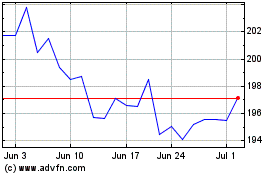By Dave Michaels
WASHINGTON -- Investigators probing whether traders at JPMorgan
Chase & Co. rigged silver prices seven years ago decided there
was no case to bring. Last week, the same agency hammered the
megabank with a $920 million fine.
How a small agency that once walked away from an investigation
of price manipulation, only to later impose its biggest fine ever
for the conduct, shows the advances government has made in using
data to uncover market manipulation, said James McDonald,
enforcement director of the Commodity Futures Trading
Commission.
"We could not have brought the JPMorgan case without the data
analytics program we have now," said Mr. McDonald, who will step
down as director this week after more than three years in the
post.
The data needed to uncover the eight-year market manipulation
scheme came from Chicago-based CME Group Inc., the operator of
exchanges including one that offers trading in gold and silver
futures. The volume of data -- including trades, orders and other
messages flooding into CME's computers -- is so massive the CFTC
couldn't store or use it when Mr. McDonald began seeking it in
2017, he said.
Five years of complete CME trading data amounts to 1.7
terabytes, or 127 million pages of information, according to
testimony in a recent trial that resulted in the conviction of two
former Deutsche Bank AG traders on fraud charges related to
spoofing.
As the CFTC added the ability to store and access more trading
data in the cloud, it also hired former Chicago traders and other
quantitative-minded employees to write programs that filter CME's
data for patterns of manipulation.
"There is really no other avenue that we have that allows us to
be as proactive [investigating] as data," Mr. McDonald said.
The tactic that JPMorgan admitted its traders used, known as
spoofing, is a rapid-fire game of placing and canceling orders that
can distort the view of supply and demand, causing prices to move
in a direction engineered by the spoofer, regulators say. The
victims are sometimes high-frequency trading firms that use
algorithms to buy and sell continuously.
The CFTC began looking for manipulation in the silver market in
2008, after the agency received requests from hundreds of investors
who complained that silver prices were being rigged. The agency
closed the probe in 2013, saying there was no "viable basis" for an
enforcement action.
"Twelve years ago, we were just conducting those types of
investigations differently. We were relying on statements presented
to us either from the entity itself or the traders in sworn
testimony," Mr. McDonald said. "We didn't have the same ability to
look beneath them to ensure they were truthful and accurate."
Two former JPMorgan traders misled the CFTC when the agency
interviewed them as part of the earlier silver-market
investigation, according to a November 2019 indictment that charged
four of the bank's former employees with crimes including
racketeering. The traders had been asked about conduct that
resembled spoofing and denied doing it, the indictment said. All of
the traders have pleaded not guilty and are fighting the charges,
which were filed in Chicago federal court.
In a deal unveiled last week, JPMorgan admitted former traders,
including the ones indicted last year, spoofed gold, silver and
U.S. Treasury futures markets. The bank also acknowledged
misconduct in trading U.S. Treasury securities, the world's most
liquid bond market. The $920 million resolution will allow JPMorgan
to sidestep wire-fraud charges if it stays out of trouble for three
years.
The CFTC has settled with or sued over 60 defendants for
spoofing-related misconduct since 2013, with nearly half of the
total coming during 2019 and 2020. Trading arms of Deutsche Bank,
Bank of America Corp. and Morgan Stanley have settled CFTC spoofing
probes over precious-metals activity.
Some traders say the government has labeled too much activity as
spoofing. Traders at big banks sometimes place and cancel larger
orders to see whether there is demand to trade in the size they
prefer. Often, the banks have clients that need to trade in larger
quantities in order to hedge business risks, said Robert Bogucki,
former global head of macro trading at Barclays PLC.
"The winners of these prosecutions will be the high-frequency
trading firms," said Mr. Bogucki, who was prosecuted and acquitted
of market-manipulation charges when a judge threw out the
government's claims against him. "The losers become the bank
trading desks, and the biggest losers become the end users, where
the rubber hits the road in the real economy."
Mr. McDonald said the CFTC's data-analytics program has become
advanced enough that some civil-enforcement cases can be brought
using just trading data, and don't require witness testimony. The
Justice Department's criminal cases have generally involved
cooperating witnesses, who may be needed to convince jurors there
was an intent to defraud.
Some Wall Street watchers say the JPMorgan settlement was
unsatisfying despite the big penalty imposed on the bank, which
earned $4.7 billion during its latest quarter. JPMorgan pleaded
guilty in 2015 to similar misconduct in the foreign-exchange spot
market, the Justice Department's filings noted.
Better Markets, a group that advocates for stricter financial
regulation, said the outcome was "grossly inadequate" because of
JPMorgan's prior settlements with regulators and law
enforcement.
The government's spoofing probes have had an impact on
misconduct, Mr. McDonald said. The CFTC sees less spoofing today
than it did "even three years ago," he said. Traders may be using
newer methods to try to illegally influence prices, he said,
including injecting misleading information on one exchange in order
to influence prices on a different one.
"So long as you have markets, you are going to have folks trying
to monkey with the markets," he said.
Write to Dave Michaels at dave.michaels@wsj.com
(END) Dow Jones Newswires
October 05, 2020 06:14 ET (10:14 GMT)
Copyright (c) 2020 Dow Jones & Company, Inc.
CME (NASDAQ:CME)
Historical Stock Chart
From Mar 2024 to Apr 2024

CME (NASDAQ:CME)
Historical Stock Chart
From Apr 2023 to Apr 2024
